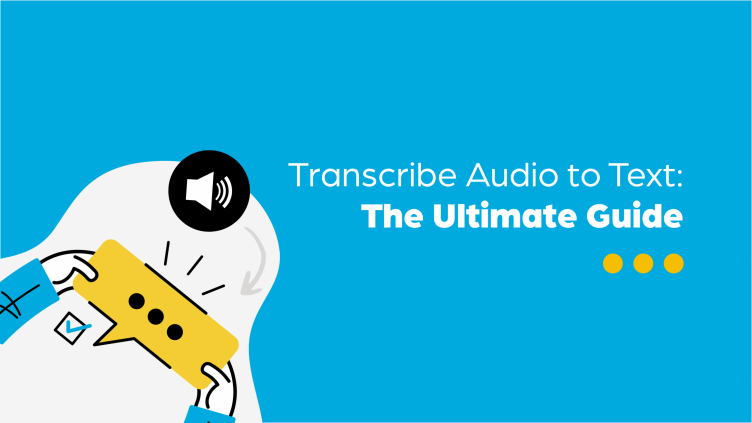How Audio to Text Transcription is Revolutionizing the Audio Content

In today’s fast-paced world, audio has become a vital source of communication. More people opt for audio content with the rise of podcasting, audiobooks, and interviews. However, audio files can be difficult to navigate, making it challenging to find relevant information. To transcribe audio to text can be a game-changer in this regard. In this blog, we’ll explore the power when we transcribe Audio to Text and how it can revolutionize how we consume audio content.
The Need to Transcribe Audio to Text
Let’s face it; audio files can be challenging to navigate. Finding a specific quote or segment can take time; sometimes, you might miss out on vital information. That’s where Transcription comes in. Transcribing audio to text can make searching for information easier, analyzing data, and repurposing content.
Moreover, Transcription can also improve accessibility. Deaf and hard-of-hearing individuals can read the text and understand the audio content. Transcription can also benefit non-native speakers who find it challenging to follow an audio file.
The Benefits of Transcribing Audio to Text
Transcription can have several benefits, including improved searchability, more accessible analysis, repurposing content, and accessibility. By transcribing audio to text, you can make it easier to find relevant information quickly, analyze data to gain insights, repurpose content for various platforms, and make it more accessible for deaf and hard-of-hearing individuals. Including the keyword “transcribe audio to text” in your content can help you rank higher in search engines and attract relevant traffic to your website. Transcription can have several benefits, including:
- Improved Searchability: You can make your content more searchable by transcribing audio to text. It benefits businesses and organizations that want to optimize their content for search engines like Google. Transcribing audio to text can also make it easier for people to find and access your content.
- Increased Accessibility: Transcription can also make your content more accessible. By providing the written text, you can make your content available to people who are deaf or hard of hearing. It can help you reach a wider audience and ensure everyone can access your content.
- Improved Analysis: Transcription can help you analyze your audio content more effectively. By having a written record of your audio, you can search for keywords, analyze patterns, and identify critical insights. It can benefit businesses and organizations that want to track customer feedback or analyze user behaviour.
- Time-Saving: Transcription can also save you time. Instead of listening to hours of audio, you can quickly scan a written transcript to find the information you need. It can benefit journalists, researchers, and other professionals who must sift through large amounts of audio content.
- Cost-Effective: Transcription can be a cost-effective solution for businesses and organizations. Instead of hiring someone to transcribe your audio manually, you can use automated transcription services that are fast, accurate, and affordable. It can save you time and money while improving your transcripts’ accuracy and quality.
The Impact of Transcription from Audio to Text
Several industries can benefit from Transcription, including journalism, education, legal, and entertainment. By transcribing interviews, lectures, court proceedings, and videos, you can quickly identify critical quotes and information, create study materials, improve accessibility, and create subtitles for movies and TV shows. Several industries can benefit from Transcription, including:
Journalism: Transcription can help journalists transcribe interviews, press conferences, and audio content. It can also help fact-check and ensure accuracy in reporting. Additionally, Transcription can help create subtitles and closed captions for news broadcasts and other video content.
Education: Transcription can help educators transcribe lectures, class discussions, and other educational content. It can also help create study materials and make educational content accessible for deaf and hard-of-hearing students.
Legal: Transcription can help legal professionals transcribe depositions, court hearings, and other legal proceedings. It can also help create accurate and comprehensive legal documents such as contracts, affidavits, and pleadings.
Entertainment: Transcription can make creating subtitles for movies, TV shows, and YouTube videos more accessible.
Medical: Transcription can help doctors and other healthcare professionals create accurate and comprehensive patient records. Medical Transcription can also help with clinical research and drug development.
Market Research: Transcription can help market researchers analyze focus groups, surveys, and interviews more effectively. It can also help track consumer trends and sentiment.
Finance: Transcription can help financial professionals analyze earnings calls, investor meetings, and other economic events. It can also help create financial reports and documentation.
Government: Transcription can help agencies transcribe speeches, hearings, and other official proceedings. It can also help create accessible versions of government documents.
Social Media: Transcription can help managers monitor and analyze social media content more effectively. It can also help create captions and transcripts for social media videos.
Conclusion
Transcribing audio to text can be a game-changer for several industries, including journalism, education, legal, and entertainment. With the rise of audio content, Transcription can make navigating and analyzing audio files more accessible. Moreover, Transcription can also improve accessibility, making it easier for deaf and hard-of-hearing individuals to access audio content. With the improvement in speech recognition technology, the accuracy of transcriptions is improving significantly. Transcription is a powerful tool that can transform how we consume audio content, making it more accessible and searchable.
So, consider transcribing it to text next time you struggle to navigate an audio file. You might be surprised by the difference it can make!

Made up your mind yet?
Empower your globalization goals today!




